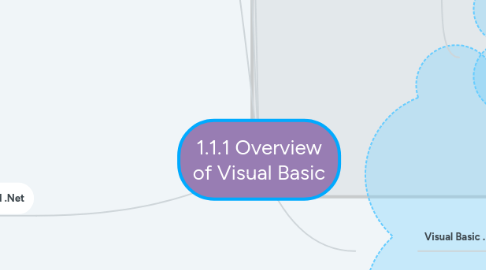
1. Visual Basic
1.1. It's a computer programming system developed and owned by Microsoft.
1.2. Created to make it easier to write programs for the Windows computer operating system.
1.3. Earlier programming language called BASIC ("Beginner's All purpose Symbolic Instruction Code") invented by Dartmouth College professors John Kemeny and Thomas Kurtz.
1.4. Often referred to using just the initials, VB.
2. History of VB and .Net
2.1. VB was created by Microsoft in 1991.
2.2. Main reason for 1st version of VB was to make it a lot faster and easier to write programs for the new, graphical windows os.
2.3. Before VB, windows programs had to be written in C++. It expensive and difficult to write and usually had a lot of bugs in them.
3. History of VB and .Net
3.1. Version, Year, Note
3.2. Visual Basic VB1
3.2.1. 1991
3.2.1.1. Project 'Thunder' was released for Windows at the Comdex/Windows World trade show in Atlanta, Georgia.
3.3. Visual Basic 1 for MS-DOS
3.3.1. 1992
3.3.1.1. This release updated Microsoft's QuickBASIC Professional Development System with a new library that enabled use of a character-based Windowing system.
3.4. Visual Basic 2 VB2
3.4.1. 1992
3.4.1.1. Forms became instantiable objects, laying the concepts of class modules as were later offered in VB4. Included ODBC for accessing a database
3.5. Visual Basic 3 VB3
3.5.1. 1992
3.5.1.1. Released in Standard and Professional versions. VB3 included the Microsoft Jet Database Engine that could read and write to the Access database.
3.6. Visual Basic 4 VB4
3.6.1. 1995
3.6.1.1. Added 32-bit code compilation. Introduced classes, giving VB object orientation though inheritance. VB4 also replaced the VBX with a new type of add-on called OCX (OLE Control Extension), based on COM, Microsoft's component programming model.
3.7. Visual Basic 5 VB5
3.7.1. 1997
3.7.1.1. Introduced the ability to create OCX custom user controls, as well as the ability to compile to native Windows executable code. VB5 no longer supported compilation to 16-bit executables.
3.8. Visual Basic VB6
3.8.1. 1998
3.8.1.1. Improved in a number of areas, including the ability to create web-based applications. VB6 has now entered Microsoft's "non-supported phase". VB6 is still in use today for maintaining existing applications. For the latest Windows OS, it must be run in compatibility mode.
3.9. Visual Basic.Net VB7
3.9.1. 2002
3.9.1.1. The first version to target the .NET Framework. VB.Net introduced full object orientation and cleaned up anomalies in the language. The language was not fully compatible with VB6 and caused difficulty in migrating existing code.
3.10. Visual Basic.Net VB8
3.10.1. 2005
3.10.1.1. The language continued to evolve, with features like the "Using" statement for freeing resources automatically. It supports generic types (a collection of objects) and nullable types (handles empty database fields). It added the ability (not too well) to modify code while debugging, called Edit and Continue.
3.11. Visual Basic.Net VB9
3.11.1. 2008
3.11.1.1. The new features are support for the language-integrated query (LINQ). Other features include extension methods, type inference, anonymous types and Lambda Expressions (nameless functions). VB has strayed far from its roots as a simple programming language. None of these additions improve productivity in developing commercial business systems.
3.12. Visual Basic.Net VB10
3.12.1. 2010
3.12.1.1. Most of the new features relate to large programming teams or object oriented programming – and are of little interest to the Visual Basic Programmer. The new features of interest are Implicit Line Continuation, Properties created in one-line statements, The Primary Interop Assembly (Microsoft Office applications) has a reduced footprint size.
3.13. Visual Basic.Net VB11
3.13.1. 2012
3.13.1.1. The new Visual Basic features are : > Better support for Asynchronous processing. > The Yield keyword to iterate through a collection. > Call Hierarchy shows where a Method is called. > Code Clone Analysis and Launch Performance Wizard. > Performance Analysis tool for tracking CPU and Memory usage.
3.14. Visual Basic.Net VB12
3.14.1. 2013
3.14.1.1. Visual Studio 2013 was released in November 2013. There was little of value or use for the Visual Basic Programmer.
4. Microsoft .Net Framework?
4.1. Software development framework from Microsoft. It provides a controlled programming environment where software can be developed, installed and executed on Windows-based operating systems.
4.1.1. Includes large class library named framework class library (FCL)
4.1.2. Provides language interoperability (each language can use code written in other languages) across several languages.
4.2. Programs written for .Net Framework :
4.2.1. Execute in a software environment (in contrast to a hardware environment) named Common Language Runtime (CLR).
4.2.2. An application virtual machine that provides services such as security, memory management, and exception handling.
